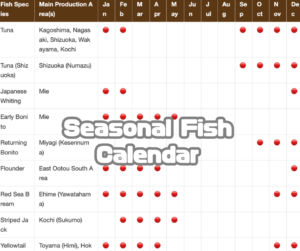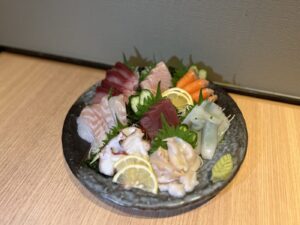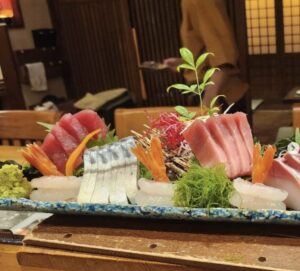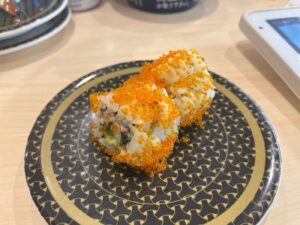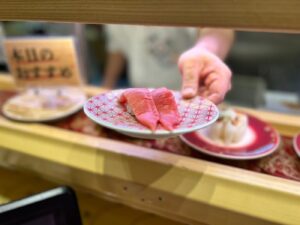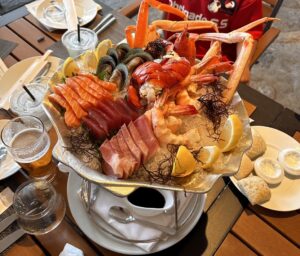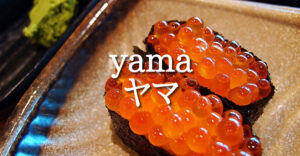Wasabi is a spice that is toony but makes it more delicious. But why is wasabi associated with sushi? Wasabi researcher Kyoko Yamane (Associate Professor at Gifu University) explains why.
(This article is excerpted from “The Japan History of Wasabi” (Bunichi Sogo Publishing) and partially modified.)
“Sushi (sushi) and wasabi” can be said to be common knowledge in the world. It can be said that it is a world-famous combination.
However, compared to the individual histories of wasabi and sushi, the combination is not so old. “Wasabi in sashimi” is a relatively new era, and “sushi ni wasabi” was not combined with wasabi when various forms of sushi existed, and wasabi became established when it encountered “nigiri sushi”.

The food culture of “nigiri sushi + wasabi” born in Edo
It was Edo that gave birth to the culture of nigiri sushi. The characteristics of Edo can be seen in Zenjiro Watanabe’s book “The Megacity of Edo Made Japanese Food.” From there, let’s first look at the historical background of the era when nigiri sushi was born.
It can be said that Edo began in the 18th year of Tensho (1590), when the Tokugawa clan entered Edo Castle. At that time, it was a very small castle, but full-scale urban development began with the establishment of the Tokugawa shogunate in the eighth year of Keicho, and over the next 100 years, a huge city with a population of one million people (half of them samurai) was formed. The economic basis of the samurai class was annual tribute income. Therefore, in rural areas, most of the rice was taken as annual tribute, and it is said that rice could not be eaten freely, but in urban areas, it was a rice-centered meal, making it the most rice-eating city in the whole country. Since white rice was eaten, it is a famous story that beriberi due to vitamin B deficiency called “Edo trouble” became popular.
Edo was also a city with an unusually high proportion of men. As a result, the culture of eating out developed. In this way, with the development of the money economy, a society with a strong consumption tendency was formed, especially with regard to food, with a strong tendency to consume, such as “no money for the evening.” Among them, there was a food culture phenomenon in which people even borrowed money and became enthusiastic about eating for the first time.

Against this backdrop, the four major Edo specialties (soba kiri, tempura, eel, and nigiri sushi) were born. Of these, nigiri sushi is the food with the newest history. The oldest of these is soba noodles, and the “Joshoji Document” (1574) is said to be the oldest record.
The specific time of the use of wasabi as a condiment for soba is unknown, but in 1751, the “Soba Zensho” written by the Edo soba condiment Nichi Shinsha Yusoba states that “yamaoi” is used as a substitute when there is no spicy radish. From this, it seems safe to assume that among the four generations of specialty foods, the earliest combination with wasabi became popular is soba noodles.
In addition, although it may not be well known, there is data that the production value per fishing ground area in Tokyo Bay was the highest Japan throughout the Meiji, Taisho and Showa periods.
In other words, it is no exaggeration to say that Edo in Japan was the world’s largest fishing ground, and it can be said that the environment that formed the foundation of the nigiri sushi boom was prepared against this background.
Taisho to early Showa period: nigiri sushi spread to the countryside with chefs
In the Edo period, nigiri sushi was positioned as “the local cuisine of Edo.” Then, when did it spread throughout the country? It is said that it spread rapidly throughout the country from the Taisho period to the early Showa period. Chefs affected by the Great Kanto Earthquake (1923) left Tokyo and moved to rural areas, and Edo’s food culture seems to have spread all at once. In addition, there were countless artisans who were expelled from Tokyo during the Pacific War, which is said to have led to the spread of nigiri sushi.
“Sushi” had a unique cooking method all over the country. What was behind the new nigiri sushi that came to dominate the Japan?

Postwar Laws and Regulations and the Nationwide Development of Nigiri Sushi
In fact, an important decree had been issued. It was the “Food and Beverage Business Emergency Measures Order” of 1947. Under the postwar food shortages, the food service industry was regulated by the United States in a situation where it received food aid. Naturally, sushi restaurants were also supposed to be targeted. However, through negotiations between a union of sushi merchants in Tokyo, the sushi restaurant was able to obtain a license to operate as a “contract processor” rather than a restaurant business by “taking processing fees in exchange for a cup of rice and making ten nigiri sushi.” As a result, sushi shops in each prefecture nationwide adopted this method, resulting in a diagram in which only nigiri sushi could do regular business. As a result, the nationwide expansion of nigiri sushi became decisive, and it is said that it has reached the present. Considering that the combination of nigiri sushi and wasabi promoted the spread of wasabi, it was an event that had a great influence on the fate of wasabi.
Is wasabi normal nowadays?
In this way, the nigiri sushi culture has been passed down to the present day. However, the combination that was thought to be the strongest of “wasabi and sushi” has begun to show signs of change in recent years. In 1958, the first conveyor belt sushi in Japan was born in Osaka, and now conveyor belt sushi is playing a part in “sushi culture.” Now, however, many children use rotating sushi shops, and sushi and wasabi are being separated. Not so long ago, “rust removal” and “rust removal” were distinguished by plates, but now almost all stores basically use “rust removal” without adding wasabi from the beginning. Even in the sushi in supermarket packs, there are almost no sushi that contain wasabi from the beginning. At this rate, I am seriously worried that the day will come when “sushi ni wasabi” will no longer be commonplace in the Japan of several generations. In the future, when this book catches someone’s eye, I feel a little frightened by the circumstances under which the relationship between Sushi and Wasabi will be read.

Characteristics of wasabi 〜It is difficult to cultivate, has a long growing season, and is not suitable for mass production!? 〜
Even though the culture of “wasabi for nigiri sushi” and “wasabi for sashimi” had been taking root since the late Edo period, wasabi was too special a plant to penetrate every corner of the country Japan as it is today. The biggest problem is that it is more difficult to grow than ordinary vegetables and has a long growing season, so it is not suitable for mass production.
In addition, since it is a plant that originally grows in an environment with a lot of moisture, it tends to lose its freshness at room temperature and in dry conditions.
In addition, the pungent taste of wasabi is volatile, and it can be said that it loses over time. In the first place, the main body of the pungent taste of wasabi is an ingredient called “allyl isothiocyanate (AITC)”, which is also found in other cruciferous plants such as mustard and radish. However, this pungent ingredient is a substance that is only produced by grating. Originally, it exists as a glycoside (sinigrin) in plants, destroys cells by grating, etc., and causes an enzyme (myrosinase) reaction, which generates volatile AITC and becomes painful. In other words, if nothing is done in the grated state, the pungent taste will be lost, and the original goodness of wasabi will be lost. However, not grating the rhizome each time would have been a considerable disadvantage from the aspect of versatility.
So, what was behind wasabi, which seems difficult to spread, to take root at the national level in modern Japan?
Development of powdered wasabi

As many have acknowledged, I also believe that the “development of powdered wasabi” was important. The first person to develop powdered wasabi was Yoshichi Konase. Based on his experience as a tea broker in Otomi Village, Shizuoka Prefecture, Yoshichi thought that “if you dry wasabi and grind it into powder, it will be very convenient to store it forever,” and embarked on the production of powdered wasabi. Initially, wasabi from the Kawane area of Shizuoka Prefecture was powdered, but this alone is unlikely to be mass-produced and the price is not worth it, so mustard powder was added so as not to spoil the flavor of wasabi. This made mass production possible, and the business is said to have been a success.
Recognized as a “seasoning”
At that time (from 1934 to after 1940), wasabi could not be mass-produced, and raw wasabi alone was not enough to provide the raw material for powdered wasabi. This fact was recognized, and the fact that powdered wasabi was a product as a “seasoning” made from horseradish was officially recognized by the Japan Fair Trade Commission on this occasion. Therefore, the Japan Fair Trade Commission has established the following rules.
Fair Competition Code (Notification No. 3 of the Japan Fair Trade Commission, Showa 44)
“Powdered wasabi” refers to dried and powdered horseradish that has been processed mainly.
At this time, since words that may be mistaken for wasabi, matters prohibiting the display of pictures, etc. were also described, the raw materials horseradish (horseradish) and wasabi are now clearly distinguished and described.
At that time, sashimi was wrapped in trays and placed in refrigerated showcases. If I attached a kneaded wasabi paste to it, it would not look good, and the flavor and pungency could be lost by the time it was served on the table. Therefore, from around this time, the development of “kneaded wasabi” became desired by the entire industry. As a result, S.B. Foods in 1972, Gold Seal Products in 1973, and House Foods in 1974 began to release “Neri Wasabi” one after another. As a result, wasabi became even more familiar and widely permeated and established as a food culture of Japan. It should not be forgotten that the background to the spread of wasabi was the tireless efforts of private companies.

